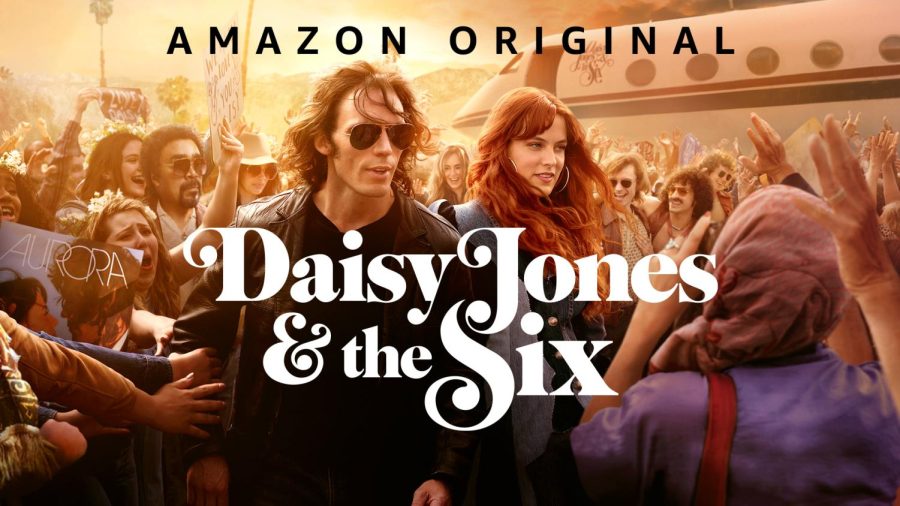The irresistible tragedy of a 70’s rock band
Nerves and adrenaline race through the band as they stand in front of the crowded stadium. The lights go off, the beat drops, and at that moment it’s just the six of them against the world. They hear their cue and realize they want to do this forever. Little did they know that this was to be their final performance. And no one ever knew why…
Decades later the band members finally agreed to reveal their truth. A truth brimming with hate, fascination, and obsession.
Daisy Jones and the Six is an enthralling television adaptation of Taylor Jenkins Reid’s best-selling novel. It tells the intricate and compelling story of the rise and abrupt demise of a fictitious 70s rock band as they deal with stardom, loss, turmoil, and heartbreak. The series, which premiered on Prime Video March 3 and was produced by the Hello Sunshine owned by the actress Reese Witherspoon. The show is a mix of electrifying performances, contagious music, amazing fashion, and an explosive journey involving drugs, alcohol, and toxic relationships.
The first three episodes start off slowly, but it’s worth sticking with because, by episodes four and five, you’re hooked. One of the most amazing aspects of the show is the riveting storytelling and its ability to engulf the audience in a world of chaos.
The series starts with interviews of all the band members set 20 years after the events.All of their recollections and memories are displayed through flashbacks and complex storylines. This develops a documentary style, enhancing the storytelling’s mystery and establishing the mood for the show as it builds intrigue and anticipation.
It is obvious something is about to go downhill which creates anticipation and tension. This technique gives the audience the chance to live through the history of the band while cutting back to the future and getting commentary on how the situations happened. Yet it keeps us in the dark about certain topics, leaving it open for us to give meaning to the situation.
The events are loosely inspired by Fleetwood Mac’s tumultuous ascent to fame, with particular emphasis on Stevie Nicks and Lindsey Buckingham’s turbulent romance. It accomplishes this by delving into the hostile, passionate, and explosive dynamic between the protagonists Billy, played Sam Claflin, and Daisy played by Riley Keough.
Their connection is incredible, and the emotion is palpable throughout, reminiscent of Nick’s and Buckingham’s rocky romance and its role in fueling their songwriting. Daisy and Billy work their screen magic, imprinting a vivid sense of the fine line between love and hatred. On one hand, Billy’s desperation and uncertainty are conveyed as he navigates between his wife Camila, who represents light, stability, sobriety, and the path toward righteousness. On the other is Daisy, who represents the dark, the broken, the toxic, and the easy way out by giving in to your demons. This battle keeps the audience longing for a response.
It’s crucial to recognize that despite these two being the central focus, all the other diverse characters in the show intertwine to create emotional explosivity and volatility. The depth of all the relationships presented makes us feel like the band is approaching a breaking point very soon, keeping the audience anxious and on edge.
This storytelling is further enhanced as the show is a sentimental ode to the time. It masterfully employs costume design, set design, and aesthetics to transport us back to the 70s. The scenery is a perfect picture shot of the time using many of the old Hollywood locations, showcasing beautiful mid-century homes accompanied by the boho chic, denim, and earthy tones that throw us right back into the 70s. We can also see characters of the show using handheld movie cameras and we get to watch the footage play out in grainy and yellowish tones, giving us the impression that we were a part of this era.
Additionally, the music takes us on a nostalgic journey of slow ballads and rock ‘n’ roll, each with its tale to tell. For me, this is the highlight of the program. The cast’s full-length album, Aurora, made available along with the movie is infectious, ravishing, and electric. The performances are fantastic but the most enjoyable aspect is the songwriting. Getting a raw view of Billy and Daisy creating harmonies, and riffs, arguing over lyrics until they land on the perfect sound is the audience’s most personal and intimate moment.
The show takes us on a journey of watching the six overcome obstacles in their attempt to make it in the industry, and it is not afraid to highlight both the positive and negative. We are aware that there are less glamorous aspects, and this understanding allows us to discuss issues like addiction, abuse, and loneliness.
Fans of the book have quickly called attention to some significant differences and expressed disappointment. The first two episodes are a little slow and heavy, but they gradually draw the viewer in. Here, we learn about the history of the band. However, in the subsequent episodes, Daisy and Billy become the only focus, losing sight of the unresolved and intriguing storylines of the other members.
The show’s actors and scenery do a beautiful job of capturing the heart of the book, despite a few minor deviations. It’s a show for music lovers that occasionally gets heavy but teaches us a profound lesson about how life imitates art through the struggles of the characters to make the right decisions and their battles with addiction, interpersonal dynamics, and self-control.




